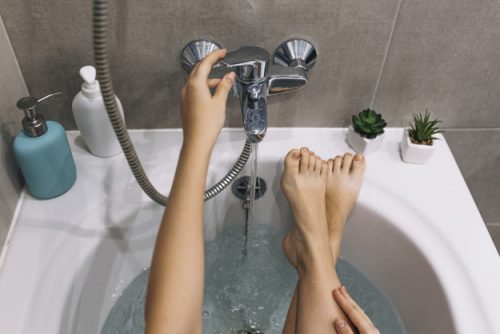The first people to learn how to make bath salts where the Chinese. Bath salts were first used by the Chinese thousands of years ago. Later also used by the Greeks, Romans, and then the English for various medical applications, bath salts were believed to present medical, hygienic, and cosmetic benefits. Epsom salt is the most familiar of types of bath salts, although perfumed and colored salts are often considered an item of luxury and self-indulgence.
Just as people enjoy making their own potpourri, candles and soaps for use throughout their home or to give as gifts, bath salts can be easily home made for yourself or your friends, family, and loved ones by following this simple guide:
Choose Your Salt
You may either choose one salt for your bath product, or mix several salts together to experience the best of each type. There are several readily available choices: Epsom salt, sea salt, Dead Sea salt, Icelandic geo-thermal brine salt, Hawaiian Red Salt, and even salt from the Bonneville Flats of the Great Salt Lake. A great mixture for a first batch is Epsom salt mixed with sea salt. Salts may be ordered online or bought at specialized retail stores.
Select Color
There are three primary types of bath salt colorant. Be sure you choose one that will not stain fabrics, the bathtub, or skin, as well as one that will not irritate skin. There are also colored salts available if that is preferred. Below are some types of salt colorant:
- Powdered mica: Gently tinted with pearly iridescence
- FD&C dyes: Liquid coloring used in soaps and for other home uses, also called “food coloring”
- Powdered soap colorant: Often used by beginners and often scented, readily available in a wide variety of colors
Pick Fragrance
If you are creating salts for yourself, choosing an essential oil scent will be easy. For anyone else, you might wish to be somewhat safe and selective in the scent, as people have very distinct likes and dislikes in regard to fragrance. Essential oils are used in fragrances, soaps, and other personal care products and are available through bath and body shops, holistic stores and online. Do not use perfumes, colognes, or manufactured scents, as they contain alcohol and other ingredients that will not work well in the salts or the bath.
Consider Botanicals
For a pretty presentation, aromatherapy qualities, and a highly personalized look, you may wish to add some botanicals to your salts. The botanicals should work cohesively with your essential oils, so do not choose varieties that conflict with your fragrant essential oils. You will need to package your finished salts in mesh or tea bags if you add botanicals, in order to keep the mixture of the salt and the leaves or flowers together.
Some great examples of botanicals for use in bath salts are:
- Aloe vera extract: Aloe is known for its healing properties and gentle scent and is particularly good for sunburns, cuts and scrapes.
- Calendula flower petals: soothing, purportedly good for acne
- Chamomile flowers: relaxingly scented, calming and said to induce a dreamlike serenity perfect for use before bedtime
- Eucalyptus leaves: When sparingly used, great for sinus or chest congestion. May irritate sensitive skin or sensitive body areas, so test on your skin before using in salts.
- Lavender flowers: calming and pretty, used for centuries as a soothing pre-sleep scent
- Lemon peel powder: an energizing and uplifting scent good for rejuvenation, will tint the bath to a slight yellow color
- Peppermint leaves: gently refreshing and soothingly familiar
If you do use botanicals, do not add basil, oregano, thyme, nutmeg, clove, cinnamon or bay leaf, as those irritate the skin.
Add Natural Moisturizers
To naturally soothe and moisturize your skin, consider adding one of the following:
- Avocado oil: golden in color, great moisturizer
- Apricot kernel: moisturizes without clogging pores, so great for oily or problem skin
- Castor oil: anti-inflammatory properties, good for skin abrasions
- Olive oil: gentle and soothing
Bath Salt Supplies
In order to make your bath salts, you will need the following kitchen items and household tools: large glass or metal bowls, whisks or spoons, decorative containers for the final product, and baking soda, as well as your salts, essential oils as desired, moisturizing oils as desired, and any botanicals. For salts with fragrance added, you should use a glass container or jar. Essential oils in scented bath salts will warp or discolor plastic. For bath salts with accompanying botanicals such as peppermint leaves or lavender flowers, use cloth tea bags or mesh bags available at hobby, kitchen supply, or specialty tea stores.
Bath Salt Recipe
The basic recipe for bath salts is:
- 3 cups salt: either one particular salt such as Epsom or sea salt, or a combination of two or more
- 1 cup baking soda
- 1 cup moisturizing oil (avocado, apricot kernel, castor, or olive)
- 5-10 drops essential oils (for fragrance, if desired)
- Few drops of FD&C coloring, as desired
Combine all of the above ingredients in a large bowl and mix well with a spoon or whisk. Place the entire recipe into a sealed container and allow it to sit for two or more days. After two days, place the salts in the decorative container or gift jar.
If you are using botanicals, ration the salts amongst several tea bags or into mesh bags and add the botanicals to each bag as appropriate. Each bath will require one to two handfuls of salts, so ration enough for at least that amount into each of the bags.
Enjoy
To use the bath salts, simply draw a warm bath and add one to two handfuls of the salts to the water by holding your hand under the running faucet and allowing the salts to flow into the tub. Fragrance will be released into the steam as the salt dissolves quickly in contact with the hot water. Either before getting into the tub, or once in the water, swirl the water around enough to ensure all of the salts are dissolved and circulated.
If using mesh bagged salts, simply steep the bag in the water just as you would steep a tea bag in a cup.




